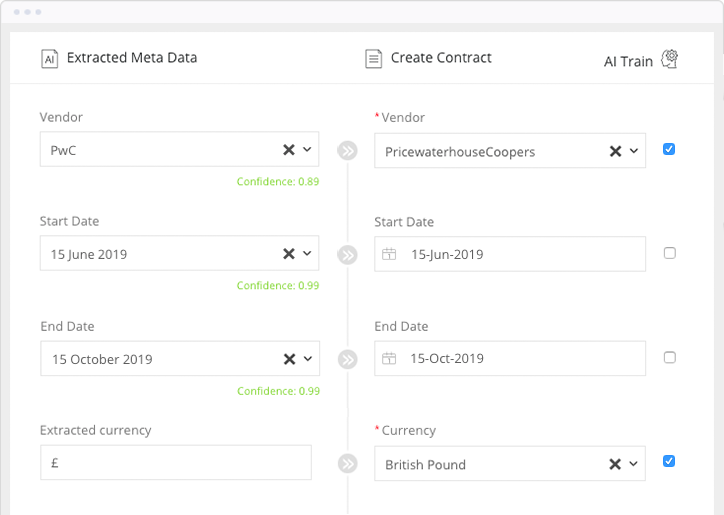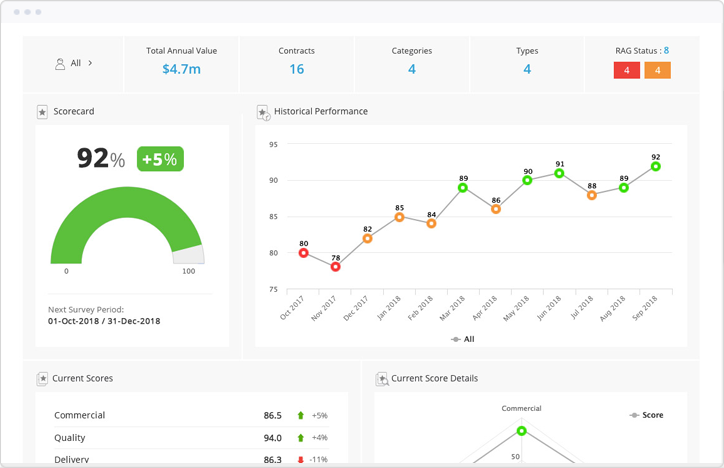“Contract Administration” and “Contract Management” are often used interchangeably to describe the internal work carried out across a company relating to its contracts.
However, there are important distinctions to be made between the two, and these have implications for how a business can extract maximum value from their signed agreements.
This article outlines the difference between contract administration and contract management, what each process involves and how contract lifecycle management software can improve both elements throughout your business.
What is contract administration?
Contract administration is about, among other things, making sure all the relevant metadata within a contract is extracted, recorded, stored and accessible to those who need it.
Contract administrators are responsible for these activities which often take place before a contract is put into effect.
With responsibility for the accurate recording all information to do with the contract itself, an administrator will usually:
- Set up the contract
- Gather information, including Requests For Proposals
- Route the contract for approval
- Extract all information, such as key dates, and make a record of it
- Keep all information up-to-date
- Ensure relevant contracts are connected
- Determine who can access the contract and certain information
A contract administrator, depending on the size of the business, will be responsible for these activities across multiple contracts and departments.
The challenges of contract administration
Contract administrators are the gateway to a company’s contracts and need to know their way around them in detail, especially in scenarios where sign-off is delayed, a term hasn’t been met, or documentation needs to be quickly found to ensure that compliance requirements are being met.
Having an accessible, centralised way to store contracts is essential for successful contract administration."
Contracts also have multiple touch points, often passing through Procurement, Sales and Legal teams before they’ve been sent back to a vendor as part of the signing process. This creates multiple opportunities for contracts and their metadata to change during the contract administration process, based on conversations happening in different departments.
As a result, administrators need to ensure they are able to collaborate with other teams while having a reliable approach to version control.
If this centralised and auditable approach isn’t in place, administrators won’t be able to collaborate effectively with contract owners, who could be at risk of working from the wrong version of a contract later on in the process.
What is Contract Management?
The definition of contract lifecycle management is the end-to-end management of a contract, from inception to closeout.
There should be no conflict or confusion, within a business, between Contract Admin and Contract Management. Instead, both functions need to work collaboratively together to ensure success.
Stages of Contract Lifecycle Management
There are seven stages in which contract management practices take place. These are:
- Inception: Contract Managers should work closely with the administration team to identify what goals need to be met, the type of suppliers that should be appraised, and what goods or services need to be obtained.
- Negotiation: Contract Managers will want to negotiate the best terms and reach a cost-effective agreement. Any redlining, changes to the terms and the draft records sent will need to be captured and recorded by the contract administration team.
- Execution: Contracts are routed to the relevant parties, signed and returned. Contract administrators will lead this process, but Contract Managers will need to know when contracts have been returned so they can execute the agreement.
- Start-Up: Administrators will extract contract metadata and add it to the central repository. Once stakeholders are aware and understand the contract, Contract Managers will obtain and assign roles for the ongoing management required.
- Operation: Contract Managers have a huge role to play during the operation of a contract, from measuring performance, mitigating risks, reviewing commercial success and managing contract disputes if needed. This monitoring of performance will ensure that contract obligations are being fulfilled.
- Renewal: When recording a contract’s data, an administrator should be disciplined in extracting renewal dates and notice periods, thereby making them easily visible for the Contract Manager. The renewal phase of a contract is a vital time for Contract Managers to act. With the right visibility, they can mitigate the risk of contracts auto-renewing, they can find cost-effective alternatives and they can create a stronger negotiating position to define better terms before the contract renews.
- Close-out: Completing a contract doesn’t mean the work has finished. Contract administrators and managers should work together to close contracts appropriately by reporting and recording performance against KPIs, filling in any missing data gaps and moving the contract record into archives.
Each of these stages is an opportunity for Contract Managers to not only ensure that the contract’s terms and conditions are being fulfilled, but to also reduce costs, enhance vendor performance and maximise the benefits realised across the business.
Challenges in Contract Management
The number of challenges faced by Contract Managers is often dictated by the maturity of internal processes within the business.
If contract administration isn’t a priority, or underpinned by best practices and a centralised way of working, problems can quickly occur.
When contracts aren’t stored in a central repository, metadata is missing and compliance certificates aren’t held against the master contracts, contract and business risk can increase exponentially."
Businesses that are juggling contract management through a combination of Excel spreadsheets, emails and shared drive are those most likely to experience challenges in contract management.
A fragmented approach to contract management, characterised by inconsistent administration, will lead to challenges such as a lack of visibility, renewals passing by unnoticed, a lack of accountability for each lifecycle stage and an inability to scale successfully with growth.
Unless a business has its people, processes and technologies aligned, Contract Managers could be left to explain:
- Why obligations have not been fulfilled by third-parties
- Why the organisation has been fined for non-compliance
- Why end users are not receiving a service they’re paying for
- Why the time-to-contract process has taken so long
- How unnecessary costs have been accumulated
- Why contract handovers have been poorly executed when someone has left the business.
- Why there has been duplicate or delinquent spend
Best Practices for Contract Administration and Contract Management
Although the processes within contract administration and contract management differ, there are a number of critical best practices that help businesses to better manage their portfolio.
1. Centralise contracts and documents
By storing contracts and documents in a central and secure location, instead of spreadsheets and shared drives, administrators and managers can:
- Quickly find contracts and information, saving valuable time
- Build a comprehensive understanding of contract obligations
- Identify contract risks such as non-compliance
- Improve version control and only work from accurate documents.
Time savings, risk reduction and improved collaboration benefit both teams when contracts are centralised.
2. Track important dates and events
Contracts can only be effectively managed when contract owners know what's on the horizon - whether that's a renewal, a document expiring or an upcoming delivery date.
Contract administrators should seek to extract and store key dates centrally. Using the right technology, notifications and alerts can be sent when important dates are approaching. This allows businesses to easily see dates, act ahead of time and eliminate the need to manually check on contracts.
3. Automate internal processes
Centralising contracts is a major step in minimising contract administration and managing your portfolio more effectively, but it's not enough on its own to resolve some of the challenges we've outlined throughout this article.
Eliminating fragmented and manual ways of working will improve contract administration and management. When activities are automated, administrators and managers can work together seamlessly - while viewing where each contract is within its lifecycle.
Automating internal contracting processes:
- Simplifies complex contract workflows, minimises bottlenecks and keeps the contracting process running swiftly
- Keeps administrators and managers accountable for the stages they own
- Keeps information visible, accessible and actionable.
The Benefits of contract management software
Intuitive contract management software can improve both contract administration and management throughout your organisation.
Whether one person is responsible for both elements or there are separate teams for each, a simple contract management solution can streamline, simplify and enhance the processes you have in place.
Below, we take a look at three core benefits.
1. Centralisation for increased portfolio visibility
Dedicated CLM software will provide a central repository where all contracts, their metadata and their relevant documentation can be stored.
This centralisation helps administrators to gain control over contracts while providing greater levels of visibility to the wider business.
With contract repository software, fragmented approaches to administration can be eliminated and seamless data capture and storing can be achieved.
As your business moves towards a contract lifecycle software, legacy contracts shouldn’t be left behind.
By adopting a solution that offers AI Extraction, administrators can upload PDFs or scan in documents for all key metadata and clause language to be auto extracted and stored.
 Gatekeeper's AI Extract capabilities
Gatekeeper's AI Extract capabilities
CLM software can also help administrators to find information quickly and easily through OCR-enabled search which enables searches through contracts, vendors and even file names.
2. Time savings through automation
Dedicated software will also support the collaboration required between contract administrators and various departments.
By automating internal processes and combining this with approval control and tracking, contract administrators can build a searchable audit trail - creating a visualisation of all the contract’s touchpoints and changes."
Contract management software that offers Touchless Contracts can also alleviate Legal teams and other individuals from the burden of contract administration associated with creation. Find out more by watching the video below.
Powerful automation allows Touchless Contract technology to create fully compliant and legal NDAs and contracts, without the need for manual intervention.
This automation will also help businesses to save their team members up to 7.5 hours a week. Watch the webinar below to find out how.
3. Proactive management to minimise contract risk
While administrators are able to seamlessly extract, record and store metadata, Contract Managers are able to see the bigger picture at a glance – enhancing their understanding of current risks, performance levels and strength of supplier relationships throughout the business.
By moving away from Excel and towards an intuitive platform, Contract Managers will be able to:
- Formalise and standardise processes, including contract renewals, to create greater accuracy across the business
- Set renewal reminders so delinquent spend doesn’t occur and alternative vendors can be explored
- Visualise and share an understanding of contract obligations with suppliers
- Identify areas of poor performance through automated tracking and scorecards
- Maintain compliance and business continuity documentation, linking reports to Master Contracts for easy access
- Assess internal, external and market risk from vendors to inform decisions
 Gatekeeper's performance dashboard
Gatekeeper's performance dashboard
Contract management solutions will provide insights into performance, risks and even spend – helping managers to maximise the value their current suppliers are delivering.
When administration is prioritised, contracts are centralised and a single source of truth is established with the right technology, businesses no longer need to focus on contract administration vs contract management."
Instead, they become fluid processes that inform one another for better business performance.
To find out how Gatekeeper improves contract administration and management, contact us today.

.png)
.png)
.png)
-4.png)